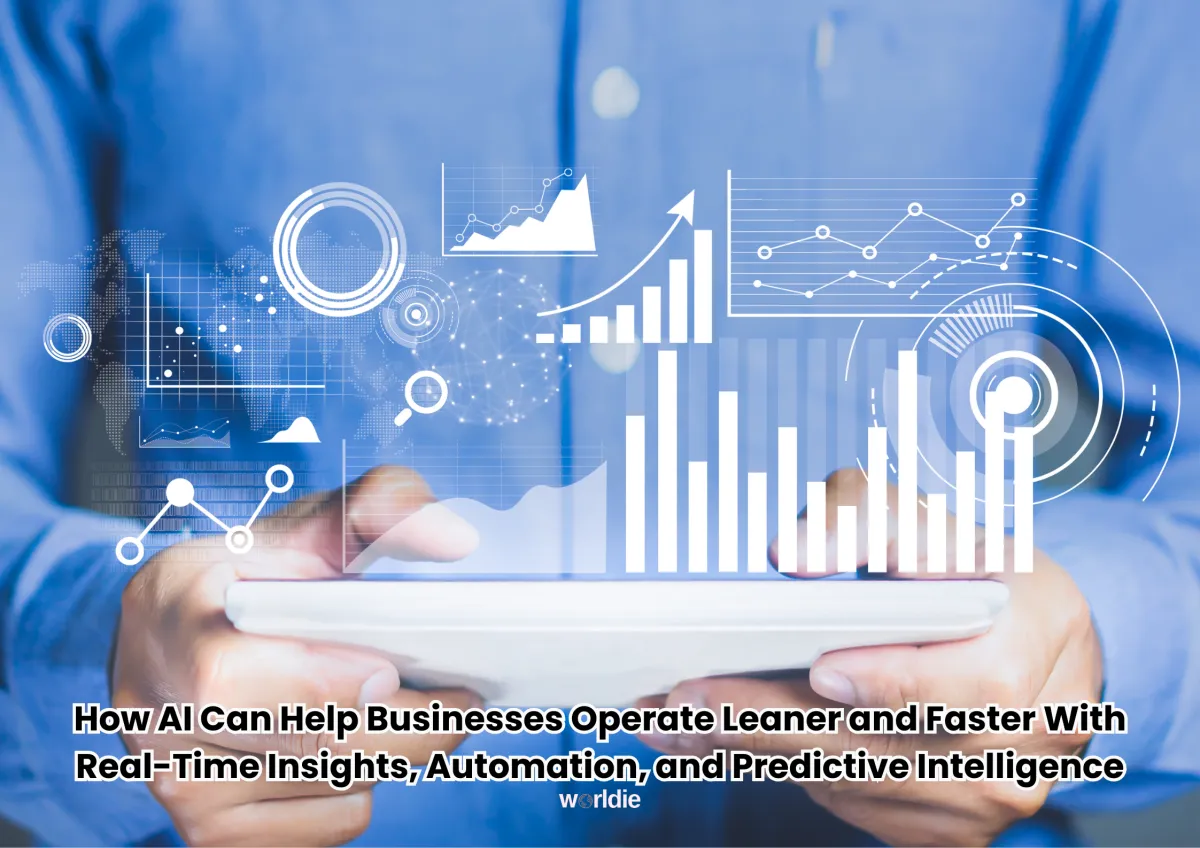
How AI Can Help Businesses Operate Leaner and Faster With Real-Time Insights, Automation, and Predictive Intelligence
How AI can help businesses operate leaner and faster is a question every founder, operator, and growth leader is trying to solve as competition rises, margins tighten, and manual execution becomes a bottleneck. Business complexity continues to increase, yet teams are expected to deliver speed, precision, and scalability without significantly expanding headcount or infrastructure. Worldie AI exists to bridge this gap by designing intelligent systems that reduce operational drag, automate decision-making, and position companies for measurable revenue transformation.
AI is no longer a tool reserved for tech giants or data-heavy enterprises. With the right strategy, even lean teams can unlock automation, predictive analytics, and integrated workflows that outperform traditional processes. The real win comes from building systems that learn, adapt, and accelerate execution without demanding constant human oversight.
This blog breaks down how modern AI unlocks leaner operations, faster execution, and scalable growth—along with the challenges, opportunities, and frameworks Worldie AI uses to help companies transition into AI-powered organizations.
Understanding the Keyword: What “How AI Can Help Businesses Operate Leaner and Faster” Truly Means
When leaders talk about operating leaner, they usually refer to reducing unnecessary effort, cutting repetitive tasks, and tightening operational workflows. Speed, on the other hand, refers to execution—how quickly a team can move from decision to action, from input to output, from idea to implementation.
AI optimizes both sides.
It compresses the space between insight and action by automating what humans normally do slowly, inconsistently, or manually. It creates systems that process, analyze, and act on data instantly. It removes operational friction not by cutting teams, but by upgrading how teams operate.
At its core, the keyword describes a shift from manual, effort-heavy processes to intelligent, self-sustaining systems. The moment businesses understand this shift, they start to recognize how AI becomes a revenue multiplier instead of just a cost reducer.
Why Traditional Business Operations Hit Efficiency Walls
Many organizations still rely on workflow patterns built decades ago, even if they’ve adopted “modern tools.” The inefficiencies are subtle but damaging.
Teams rely heavily on manual decision-making. Data sits across fragments. Customer interactions require human triage. Departments operate as independent silos. And when the business grows, these systems don’t scale—they strain.
Common patterns include:
Data being collected but not used for real-time decisions
Teams spending hours on repetitive work that adds no strategic value
Bottlenecks created by approvals or manual intervention
Processes optimized for past needs, not current demands
Technology stacks that do not communicate with one another
The consequence is slower execution, higher operating costs, and a limit to how far the business can scale without burning out its workforce or adding unnecessary complexity.
AI removes the invisible weight slowing companies down.
How AI Can Help Businesses Operate Leaner and Faster Through Intelligence, Automation, and Acceleration
The core benefit of AI lies in its ability to eliminate friction. It does this through several mechanisms that boost speed, accuracy, and consistency.
AI turns raw data into actionable direction. Instead of waiting for a weekly report or a monthly analytics review, decision-makers can access insights instantly. The system surfaces opportunities, detects problems, and proposes actions before they escalate.
AI also transforms workflows into automated pipelines. It handles tasks humans used to spend hours on, from processing information to generating content, routing customer queries, analyzing behaviors, predicting outcomes, and implementing actions.
The faster the system learns, the leaner the operation becomes. Teams gain clarity, execution becomes consistent, and the business gains momentum that was previously impossible.
Use Cases Across Industries: How Lean, AI-Driven Operations Create Scalable Impact
AI is not limited to one sector. Its adaptability means almost every industry can apply it to its own bottlenecks.
Retail and eCommerce benefit from predictive demand modeling, automated product recommendations, and intelligent fulfillment. Teams spend fewer hours forecasting or resolving logistics issues because the system predicts needs beforehand.
Service-based companies rely on AI to automate scheduling, client communication, invoicing, and workflow routing. This allows lean teams to manage high client volumes without losing quality.
Healthcare organizations use AI to automate patient intake, triage, reporting, and follow-ups. Physicians and nurses spend more time on care and less on administrative tasks.
Manufacturing uses AI for anomaly detection, predictive maintenance, and real-time quality checks. Production lines become faster and less prone to error.
Professional services automate research, document generation, data summarization, and client updates. This reduces delivery time and increases billable efficiency.
Real estate firms use AI to automate lead routing, property matching, valuation models, and communication workflows. Agents execute faster while maintaining stronger pipelines.
Every industry gains an edge when humans and AI collaborate instead of competing for the same tasks.
The Worldie AI Framework: Design → Build → Release
Worldie AI approaches AI transformation through a structured architecture built to reduce risk while maximizing impact.
The design phase identifies inefficiencies, data sources, workflow gaps, and revenue opportunities. Instead of plugging AI into random processes, Worldie AI evaluates the entire operational structure. This ensures the system supports business goals rather than creating new complexity.
The build phase focuses on developing the AI models, integrations, data pipelines, and automations needed for intelligent operations. This is where the system is trained, refined, and aligned with how the business actually functions. The system becomes capable not only of automating tasks but also interpreting context and learning from outcomes.
The release phase activates the system inside the organization. Teams are trained. Processes are adjusted. Automations are monitored. Data flows are validated. The system begins supporting—and eventually accelerating—the company’s daily operations.
This structured approach ensures that AI implementation becomes a transformation, not a disruption.
Challenges in Deploying AI and How Worldie AI Helps Teams Overcome Them
AI adoption can feel overwhelming without a strategic partner. Many teams worry about data quality, integration barriers, or internal readiness. These challenges are valid and require expertise to navigate.
Some companies lack organized data. Others have fragmented systems that do not communicate. Many teams are uncertain how AI fits into their workflow identity. And most leaders are unsure how to measure ROI beyond surface-level metrics.
Worldie AI helps tackle these challenges through data preparation, integration refinement, workflow mapping, and team enablement. Instead of forcing organizations to adapt to AI, the system is molded to fit the organization’s existing strengths.
This ensures a smoother transition and avoids the internal friction that often delays or derails AI adoption.
Metrics That Measure How AI Helps Businesses Operate Leaner and Faster
Every organization wants faster execution and reduced operational drag, but without measurable indicators, the impact becomes hard to justify.
Clear metrics include:
Reduction in manual hours
Faster turnaround times
Higher conversion rates due to predictive insights
Increased operational throughput
Reduction in errors or inconsistencies
Faster response times across customer touchpoints
Improved data visibility and decision accuracy
Higher revenue per employee
When leaders observe these shifts, they begin to recognize AI not as a cost center but as a strategic investment that reshapes the economics of the business.
Real-World Transformations: What Happens When Lean, AI-Powered Operations Activate
Organizations that adopt AI-driven systems notice patterns that become impossible to ignore.
Teams become more effective because they spend less time on repetitive tasks. Leaders gain clarity because they make decisions based on dynamic insights rather than static reports. Customers receive faster, more accurate support and better experiences. Cross-department workflows move quickly because they no longer depend on manual routing or outdated systems.
These transformations compound over time. The company operates with less friction, fewer bottlenecks, and stronger alignment between departments. Growth becomes easier to sustain. Revenue becomes easier to predict. Execution becomes easier to scale.
When AI is architected correctly, it becomes a silent engine powering the entire business.
Conclusion: Why Worldie AI Is the Strategic Partner for Lean, Fast, and Scalable Growth
AI is redefining how businesses operate, compete, and grow. The companies winning today are not simply using AI tools—they are building systems that enhance precision, strengthen operational flow, and accelerate execution at every level. Worldie AI delivers this by designing intelligent infrastructures that help businesses operate leaner and faster, turning complexity into clarity and effort into opportunity.
Where others implement AI as a feature, Worldie AI builds AI as a foundation. That difference is what drives real revenue transformation.
FAQs
1. How long does it take for AI to start helping a business operate leaner and faster?
The timeline varies depending on a company’s existing systems, data readiness, and the complexity of the workflows being automated. Many organizations begin noticing early improvements within the first weeks of deployment, with full operational impact unfolding as the system continues learning and adapting.
2. Do businesses need clean or perfect data before working with Worldie AI?
Perfect data is not required. Worldie AI works with companies to organize, refine, and structure their existing data so the system can learn effectively. The goal is to help teams evolve their data practices while simultaneously deploying AI-driven improvements.
3. Can AI replace human teams or reduce headcount?
AI is far more effective as a performance amplifier than a replacement for human teams. The real advantage appears when teams use AI to eliminate repetitive tasks and redirect their focus toward strategic work, creativity, problem-solving, and relationship-driven activities.
4. How do leaders know which processes to automate first?
Worldie AI maps a company’s workflows, pain points, and growth bottlenecks to identify high-impact automation targets. The priority typically goes to processes that consume the most manual hours or create delays in customer experience, delivery, or decision-making.
5. What type of ROI can companies expect from operating with lean, AI-powered systems?
ROI varies by industry and business model, but most organizations experience gains through reduced labor hours, faster execution, increased conversion rates, higher output capacity, and improved customer satisfaction. These combined effects typically create compounding returns over time as the AI system continues to optimize performance.

